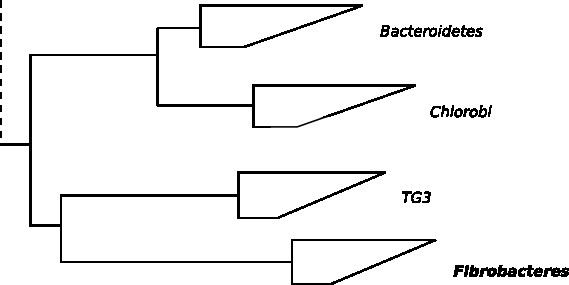Domain Bacteria Higher classification Bacteria | Scientific name Fibrobacteres Rank Phylum | |
 | ||
Similar Bacteria, Dictyoglomus thermophilum, Ruminococcus, Gemmatimonadetes, Thermodesulfobacteria | ||
Fibrobacteres is a small bacterial phylum which includes many of the major rumen bacteria, allowing for the degradation of plant-based cellulose in ruminant animals. Members of this phylum were categorized in other phyla. The genus Fibrobacter (the only genus of Fibrobacteres) was removed from the genus Bacteroides in 1988.
Contents
Phylogeny and Comparative Genomic Studies
Although Fibrobacteres, which consists of a single genus Fibrobacter containing two species, is currently recognized as a distinct phylum, phylogenetic studies based RpoC and Gyrase B protein sequences, indicate that Fibrobacter succinogenes is closely related to the species from the phyla Bacteroidetes and Chlorobi. The species from these three phyla also branch in the same position based upon conserved signature indels in a number of important proteins. Lastly and most importantly, comparative genomic studies have identified two conserved signature indels (a 5-7 amino acid insert in the RpoC protein and a 13-16 amino acid insertion in serine hydroxymethyltransferase) and one signature protein (PG00081) that are uniquely shared by all of the species from these three phyla. All of these results provide compelling evidence that the species from these three phyla shared a common ancestor exclusive of all other bacteria and it has been proposed that they should all recognized as part of a single “FCB”superphylum.
Taxonomy
The currently accepted taxonomy is based on the List of Prokaryotic names with Standing in Nomenclature (LPSN), National Center for Biotechnology Information (NCBI) and the 16S rRNA-based LTP release 123 by 'The All-Species Living Tree' Project.
Notes: ♠ Strains found at the National Center for Biotechnology Information (NCBI) but not listed in the List of Prokaryotic names with Standing in Nomenclature (LSPN)
Distribution
The phylum Fibrobacteres is considered to be closely related to the CFB [Cytophaga-Flavibacterium-Bacteroides]. The only genus in this phylum is Fibrobacter that contains strains from the guts of many mammals including cattle and pigs. The two described species in this genus namely, Fibrobacter succinogenes and Fibrobacter intestinalis are important members of fibrolytic communities in mammalian guts and have received a lot of attention in recent decades due to the long-standing interest microbes capable of degrading plant fiber.
Molecular evidence based on the amplification of 16rRNA genes from various environments suggest that the phylum is much more widespread than previously thought. Most of the clones from mammalian environments group along with the known isolates in what has been called Fibrobacteres subphylum 1. Members of Fibrobacteres subphylum 2 however, have so far been found only in the gut of termites. and in some litter-feeding cockroaches. The predominance of Fibrobacteres subphylum 2 in cellulolytic fibre-associated bacterial communities in hindguts of wood-feeding Nasutitermes corniger suggests that they play an important role in the breakdown of plant material in higher termites.
